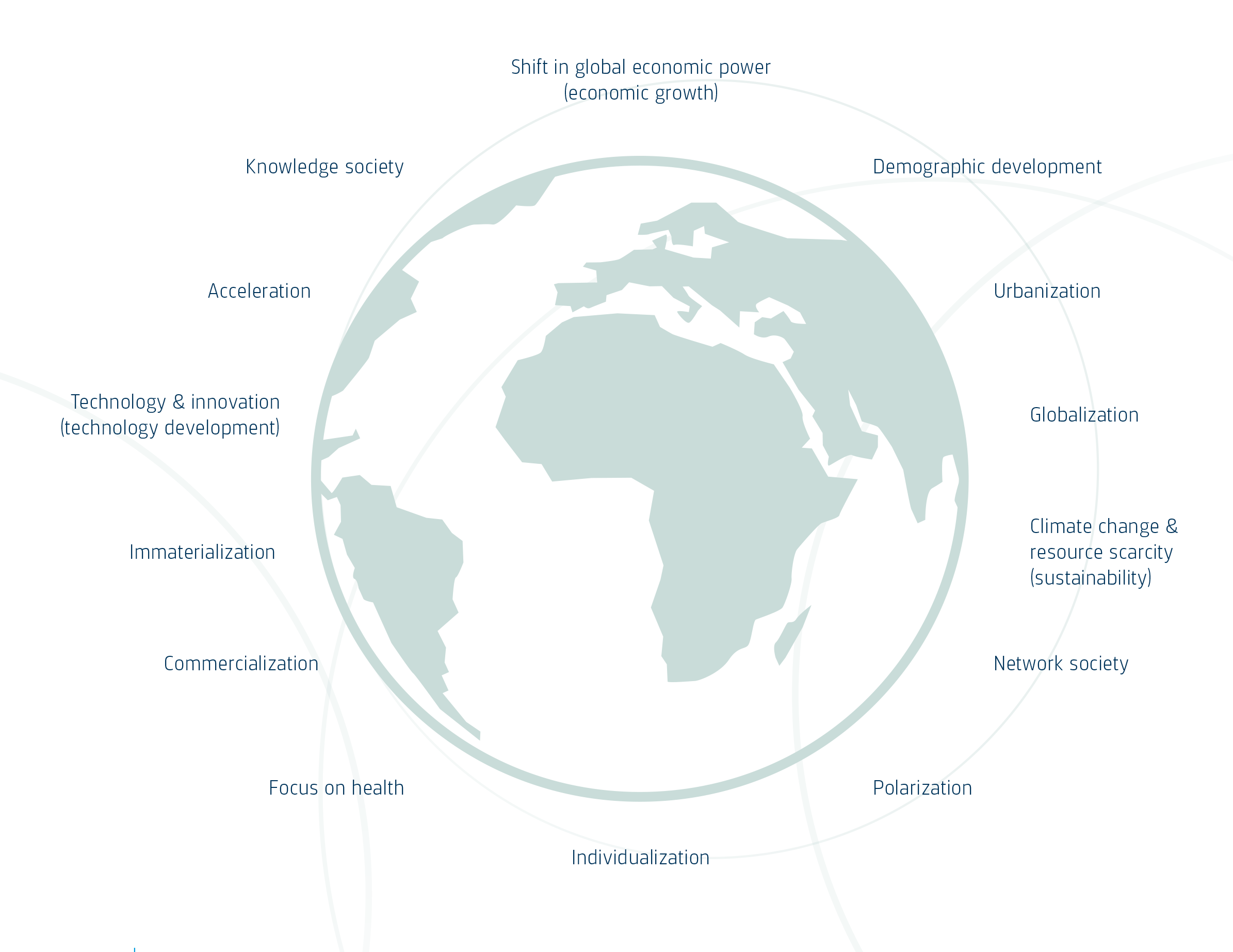Welcome to the Beyond Tomorrow report on the future of product development.
The team at the Copenhagen Institute for Futures Studies (CIFS) together with Brüel& Kjær is proud to present to you the result of the Beyond Tomorrow Scenarios2030 vision study.
Beyond Tomorrow is a scenario study that aims to identify important strategic focus areas that product developers should consider when planning for the future. The ambition of CIFS is to give you - the reader - a study that maps key trends, critical uncertainties, and plausible scenarios shaping the future of product development as well as the role of sound and vibration in product development across sectors and countries.
In the report, you will find key insights, ideas, and strategic perspectives on product development towards 2030 that will inspire and help you think strategically about your future and the future of the product development team you are part of.
Global Megatrends
Megatrends are the major pathways of development. They help make sense of the complexity of the surrounding world and provide a platform for taking action and developing strategic responses(such as new product development). Megatrends represent global trends, which are transformative, world-changing patterns that impact business, economy, society, culture, and individuals.
Megatrends do not exist or develop in isolation; they are characterized by interactivity and feedback loops. Changes in one megatrend or various interrelated trend ecosystems can impact the development of numerous other trends.
Head of Audio and Acoustics Group Microsoft
Based on analysis of global megatrends as well as input from expert interviews, a questionnaire answered by around 1,000product development specialists across the globe, desktop research, and discussions with Brüel & Kjær management, CIFS has identified the following key trends that are critically relevant for the future of product development processes.
These key trends from the contextual environment for product development across sectors and geographical areas. They consist of megatrends –described above – as well as other trend material. Please note that some of the trends in the contextual environment overlap and interact – for example, Internet-of-things and the 4th industrial revolution, which are interconnected, but also stand-alone trends.
Trends for Product Development
- 4th Industrial Revolution - New technologies and broader technology diffusion on a global basis create new opportunities and new businesses, as well as new ways to tackle existing challenges in production, product development, and services.
- Internet-of-Things (IoT) - IoT is a trend reflecting the increasing number of physical objects that are connected to, and communicating over, the Internet.
- Acceleration & Complexity - Acceleration and complexity is a global phenomenon that refers to the fact that change is happening faster than before, which in turn increases complexity – both in relation to business environments and society in general.
- Smart Cities - A smart city is an urban ecosystem that uses digital technology to drive efficiencies in existing social, economic, and environmental processes, while simultaneously opening avenues for new, data-driven processes and innovations.
- Co-Creation & Maker Culture - Technological platforms and universal connectivity allow consumers to co-create products, driving a deeper integration of all parts of the value chain.
- Business-Model Innovation - Product development processes will broaden their strategic reach and fit to remain relevant in a future where innovation is more about new business models and processes than new services and products, requiring more diverse product development teams.
- Open Innovation - Processes characterized by open innovation (incorporating external ideas in the innovation phase), decentralized collaboration, and crowdsourcing (i.e., open-sourcing) will grow in importance as models for value enhancement, innovation, and ideation.
- Servitization - Servitization is where a service is placed on top of a product. We will see more of this trend within product development, which will significantly impact how products are designed during the development phase.
The Future of Product Development
The scenarios developed in the Beyond Tomorrow process are designed to provide four qualified and possible futures related to product development, including the role of sound and vibration. The scenarios should challenge and inspire organizations and product development teams to anticipate and plan for multiple, plausible futures.
The four scenarios have been developed around two critical uncertainties, which CIFS and the Brüel & Kjær ProjectAdvisory Board have determined will have a decisive influence on product development processes towards and beyond 2030.
But the Beyond Tomorrow concept is still very much in progress. The future is always in flux and preparing for it is not a fire-and-forget activity. To ensure that product development processes and targets are win-win for both producers and consumers, we need to keep the conversation going and help shape 2030.
The Beyond Tomorrow: Scenarios 2030 Waves insert summarizes the process to date and provides insight for evaluating your journey to 2030. Download the full Beyond Tomorrow 2030 Vision Study PDF from this link:

뉴스레터를 구독하고 소리와 진동에 대한 최신 이야기를 만나보세요



